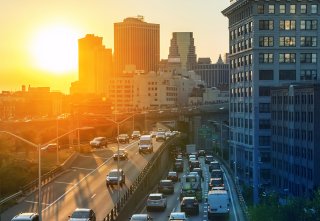Reduce Heat Islands

"Heat islands" occur when cities replace natural land cover with dense concentrations of pavement, buildings, and other surfaces that absorb and retain heat. The heat island effect increases energy costs (e.g., for air conditioning), air pollution levels, and heat-related illness and mortality. Extreme heat events often affect certain populations first, with factors like age, race, income, and location playing a role in who is most at risk from extreme heat. By adding natural surfaces like vegetation back into communities, green infrastructure can mitigate the heat island effect and provide cooling.
Rising temperatures are expected to lead to more frequent, more intense, and longer heat waves during summer months. As heat waves and rising temperatures occur, green infrastructure can be a crucial tool for communities to improve health, safety, and comfort.
Explore the sections below to learn how green infrastructure can provide cooling benefits and mitigate the effects of heat islands.
On this page:
Using Green Infrastructure to Reduce Heat Islands
Trees, green roofs, and vegetation can help reduce heat island effects by shading building surfaces, deflecting radiation from the sun, and releasing moisture into the atmosphere. Visit EPA's Using Trees and Vegetation to Reduce Heat Islands webpage to learn more.
Improve Vegetation Cover
Planting trees and other vegetation leads to a cooling effect. Space in areas might be limited, but communities can integrate small green infrastructure into grassy or barren areas, vacant lots, and street rights-of-way.
Communities can make traditional water quality practices serve double duty by adding trees in or around roadside planters and other green infiltration-based practices to boost roadside cooling and shading. Examples include native, drought-tolerant shade trees and smaller plants such as shrubs, grasses, and groundcover. However, trees should be added in coordination with the green infrastructure designer or with the overall design of the approach in mind. If not integrated into the approach properly, tree roots can impair the approach's structure or functionality.
Case Study: Evaluating Tree Canopy in Louisville, Kentucky
In 2014, city officials in Louisville, Kentucky, awarded a $115,700 contract for a tree canopy assessment to help the city use trees to address urban heat, stormwater management, and other concerns. "Knowing where we lack canopy, down to the street and address level, will help our efforts exponentially," remarked then-Mayor Greg Fischer. The study found that Louisville trees provide over $389 million in annual benefits through stormwater interception, temperature moderation, energy savings, increases in property values, air quality improvements, and carbon mitigation.
Build Green Roofs
Green roofs are an effective heat island reduction strategy, providing both direct and ambient cooling effects. They also improve air quality by lowering temperatures, absorbing pollutants, and preventing additional air pollution (pdf). Many communities offer tax credits for installing green roofs. Communities can check their local government's website for opportunities. Examples of current programs include the RiverSmart Rooftops Green Roof Rebate Program by the District of Columbia and the Green Roof Tax Credit Program by the city of Philadelphia, Pennsylvania.
Prioritize Green Infrastructure in Regular Upgrades
Building green infrastructure improvements into regular street upgrades and capital improvement projects can help ensure continued investment in heat-reducing practices throughout your community. See five strategies that can be used to reduce heat islands within ongoing and planned updates, and explore EPA's Community Actions Database for implementation examples. Communities should also consider local concerns.
Resources
Guides and Fact Sheets:
- EPA Green Infrastructure in Parks: A Guide to Collaboration, Funding, and Community Engagement (pdf) — A guide for encouraging partnerships between park agencies and stormwater agencies to promote using green infrastructure on park lands.
- EPA Region 5 Resource: Stormwater Trees (pdf) — A how-to technical memorandum for improving success of urban tree programs.
- EPA Heat Island Program — Clearinghouse for resources, tools, and educational materials on heat island effects.
Reports and Studies:
- Reducing Urban Heat Islands: Compendium of Strategies, Chapter Three: Green Roofs — This EPA publication describes the causes and impacts of summertime urban heat islands and promotes strategies for lowering temperatures in U.S. communities.
Tools:
- Adapting to Urban Heat: A Toolkit for Local Governments — This toolkit is designed to help local governments reduce the effects of increased heat on their communities and citizens. It provides an analytic tool for policymakers to consider a combination of four built environment changes (cool roofs, green roofs, cool pavements, and urban forestry), providing clear criteria for selecting among these approaches.
- iTree — A U.S. Forest Service analysis tool for urban forest managers. It uses tree inventory data to quantify the dollar value of annual environmental benefits (e.g., energy conservation, air quality improvement, carbon dioxide reduction, stormwater control, and property value increase).
